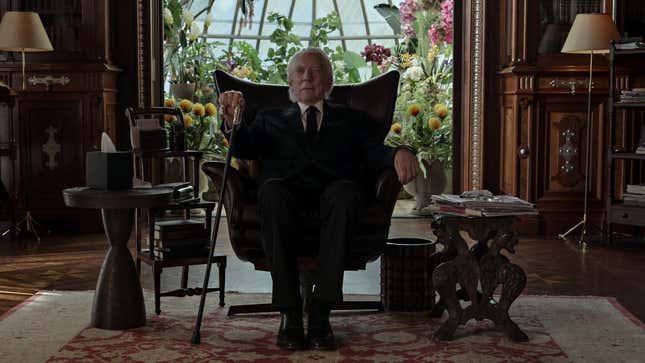
More akin to a stern lecture by a grownup than an eerie, unsettling cautionary tale, writer-director John Lee Hancock’s adaptation of Stephen King’s short story Mr. Harrigan’s Phone might have succeeded better if it didn’t completely collapse into boomer-style commentary about how modern technology is terrible and will inevitably lead to humankind’s downfall. Though its narrative contains some subtleties, and Hancock’s aesthetic polish gives it a nice gloss, the picture’s pacing and character-driven momentum frequently sputters, ultimately leading to diminished results.
Sullen, painfully shy young Craig (Colin O’Brien) is suffering from grief over the death of his mother when he’s recruited by his tiny town’s wealthiest citizen, John Harrigan (Donald Sutherland), to read books to him three times a week. The elderly billionaire businessman—one with a reputation for ruthlessness—is losing his eyesight and, though he won’t admit it, desperate for companionship. Though Craig’s unsure why he’s been selected for the gig, his father (Joe Tippett) believes visiting Mr. Harrigan’s gothic mansion will do him good. And magically, it does.
As the years fly by, Craig (now played by Jaeden Martell) matures into a better and more sophisticated reader, able to analyze the masterpieces he’s read to Mr. Harrigan, who has also come out of his shell as a result of their interactions. Now a high school freshman, Craig’s aspirations to fit in with the popular crowd drive him to take part in the early aughts’ smartphone revolution. He drags his elderly boss into it too, setting him up with a customized phone. Yet when Mr. Harrigan suddenly dies, strange things begin happening with their cell phones—one of which is interred with the corpse.
Almost immediately, the film teases a better, craftier hook into the story than the one it pursues, involving elements like Craig’s winning lotto ticket and a jagged quarry filled with murky water. Even high school bully Kenny (Cyrus Arnold) is underdeveloped as the catalyst for Craig’s initial change: he’s conceived more as a broad caricature than an imposing, intimidating force, and consequently so difficult to take seriously that he interrupts the film’s otherwise sinister tone.
Though the film clearly means to examine whether our empathetic protagonist can be corrupted, Hancock injects this question into his story too subtly. A perhaps more nihilistic director would have been better equipped to handle it—especially since Hancock becomes bafflingly intent on wrapping things up with a trite, predictable conclusion instead of letting things be messy and dynamic. Harrigan’s ominous predictions about the internet’s corroded future—foreshadowing part of our hero’s journey—also get reduced to a clunky monologue instead of reinforcing thematic elements in the story.
That said, Hancock and his stable of frequent collaborators give the picture an alluring, semi-spooky appeal. Cinematographer John Schwartzman augments the malcontent bubbling beneath the surface of these characters and their conundrums. Production designer Michael Corenblith styles locations—especially Harrigan’s oppressive, dark-wood manse and Craig’s cozy, tidy home—with a strong, sharp contrast reflecting the opposing inhabitants’ sensibilities. Editor Robert Frazen’s use of montage breathes crisp life into the straightforward story.
Martell adapts well to King’s storytelling, after delivering an insightful, vulnerable performance in It (2017). He nimbly illuminates hidden facets of Craig’s inner conflicts, shading his angst-riddled character with compelling dimensionality. Meanwhile, Sutherland’s sheer presence drives a large part of his performance. Sitting at attention in a sharp-shouldered, wing-back chair in the kind of clean-lined suit a yakuza boss would copy (or he copied from), his character’s inspired look seems almost vampiric. He earns the film’s one intentional laugh, absolutely nailing the temperament of a misanthrope’s curt phone manners.
History’s superior Stephen King adaptations—Stand By Me, Carrie (1976), It (1990 and 2017), 1408, Gerald’s Game, and even The Shining (which King famously doesn’t like)—make the task of adapting him look easy, in comparison to less successful efforts. Hancock’s attempt evokes a forgettable Black Mirror episode more than it does any of these venerated films. Although Netflix has a solid history of cranking out King’s content (also releasing 1922 and In The Tall Grass), subscribers may not be willing to answer the call on Mr. Harrigan’s Phone.